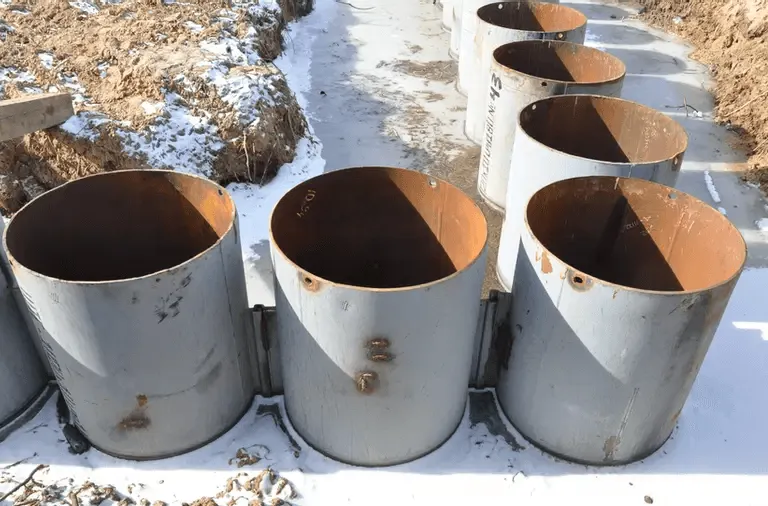The pile of pipe pipe
Today, the technologies for the installation of pits using a shpunta fence from pipes are actively used by construction companies both in civil and industrial construction. The pipe -pipe welded (STS) is a metal pipe equipped with a pair of longitudinal groove locks, which serve for a sequential connection of individual elements into a common protective structure. The high strength of the created designs, tightness, the ability to use technology on various soils and in any climatic conditions, the possibility of repeatedly used pipes that are part of the shopant fence are the main advantages. And these advantages fully justify the higher price compared to other types of fences.
Why do you need a shpunti fencing?
The pit is not just a “deepening” in the ground. The pit is a full -fledged workplace for upcoming construction, and its reliable device is an important engineering task in itself. The main requirement is security for people and technology. The walls of the unequipped pit can be crumbled, for example, due to weather conditions and the operation of heavy equipment for piles, soil waters can penetrate the areas of work. All this can lead to various emergency situations.
That is why the current SNiPs provide for the need to strengthen the walls of the pit already in cases where its depth exceeds 1 meter (in sandy soils). And even in the most durable soils, the strengthening of the walls is necessary if the depth is 2 or more meters.
The use of rogue fences from pipes allows you to reliably fulfill these requirements, while the protective structure can have any geometric contour, which is especially important during construction in urban conditions.
Used technology and equipment
To form a protective contour of the pit from the pipes, it is necessary to sequentially install separate shpunta elements in the soil, achieving their sequential hermetic compound. For immersion in the soil, various methods can be used, for example, clogging, screwing, vibration loading.
The most “straight” and at the same time low method - clogging; However, in this case, the work of a copra can lead to a shedding of walls that have not yet been strengthened. Walking pipes requires their additional preparation.
Today, the most popular technology is vibration loading. The vibration loader presses on the installed element with its own weight while “supporting” of low -amplitude fluctuations, which allows you to smoothly immerse the element in the soil, without having negative effects on the foundations of the nearby structures, which is especially important in the “constrained conditions” of urban construction. Vibro -loading is effectively used on almost any type of soil, especially on sandy, sandy and clay rocks.
For the installation of pipeline fences, a technician on a caterpillar and wheel move can be used. The caterpillar has greater power, but its delivery to the construction site requires special transport, which affects the price of the work performed.
Technology of the pile of pipe pipe
The process of creating a spontium fence occurs in a quite logical way.
Copy equipment arrives at the construction site, the required amount of pipeline is delivered, as well as transitional elements with which the “turns” of the structure in the desired places of the circuit are provided. The marking of the future shop fence is made around the perimeter of the pit. Further, the components of the entire structure are sequentially immersed in the soil and join each other to the complete “close” of the contour.
Of course, the technology is only simple “on paper”. Proper installation requires accurate “marking on the ground” and high professionalism of the installation operator, since errors can lead to damage to the groove locks of pipelines and the need for re -installation.
How to calculate the shopant fencing of the pit?
The rules for calculating protective shopant structures are fixed to SNiP No. 2.09-03. The main task when designing is based on the required strength to calculate the most effective size of the pipes and the necessary depth of their immersion.
Calculations are conducted by specialists of design companies. In the process of calculations, it is necessary to use such important parameters as the required stability of the spont in the ground, the coefficient of spont operation in the ground, the coefficient of reliability, the strength of the spont in the material and a number of other important characteristics that affect the final strength and stability of the entire protective contour.
The results of the calculations are reflected in the technological map, which indicates the sizes of the spont and its required quantity, the technology for its installation and recommendations for further work.
As a rule, trumputs with a diameter of 530 to 1520 mm are used to install a protective contour of pits in civil and industrial construction.
pipe -punted contours - where else are used
The use of pipe -punted structures allows you to effectively solve the problem of reliable strengthening of the pit in any soil and under various conditions, for example, climatic and seismic.
Also, a significant “front of work” for such designs is the strengthening of slopes and embankments of roads of various types, strengthening the coastline, the construction of hydraulic structures, the construction of hermetic containers for the disposal of industrial waste and a number of other important tasks.
Demand for a pipeline is growing. To meet the needs of the builders, the Zagorsky Pipe Plant constantly increases the capacities for the production of pipeline -wire profiles, equipping them with various types of locking joints, including their own developments. Today, the plans of the enterprise near Moscow - access to the supply of 100 & nbsp; 000 tons of pipeline per year.


